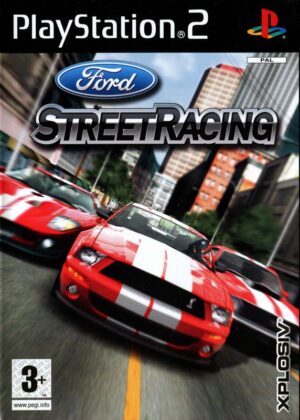Retro Replay Review
Gameplay
EyeToy: AntiGrav puts your body at the center of the action, requiring you to lean, crouch, and wave your arms to pilot a high-speed hoverboard across five distinct tracks. Unlike conventional racing games that rely on button presses or analog sticks, this title asks you to become the controls themselves. The head-and-hands recognition system is impressively responsive most of the time, translating large movements into sharp turns, jumps, and tricks that feel intuitive once you get the hang of it.
(HEY YOU!! We hope you enjoy! We try not to run ads. So basically, this is a very expensive hobby running this site. Please consider joining us for updates, forums, and more. Network w/ us to make some cash or friends while retro gaming, and you can win some free retro games for posting. Okay, carry on 👍)
The game’s design draws clear inspiration from extreme sports titles like SSX, rhythm games such as DDR, and futuristic racers like Stun Runner. Players must not only navigate tight corners and avoid obstacles, but also perform tricks mid-air by striking specific poses. While some tricks feel seamless, others require precise timing and positioning in front of the EyeToy camera—leading to occasional moments of frustration if the system misreads your movement.
With eight unique hoverboarders each boasting slightly different stats—top speed, agility, and trick proficiency—the game encourages replayability as you experiment to find the rider that best matches your personal play style. The five tracks themselves range from a crumbling Chinese wharf peppered with shipping containers and flickering lanterns, to the polished ramps and catwalks of a professional hoverboarding arena. Each course introduces new environmental hazards, alternate routes, and opportunities to chain combos for bonus points.
Graphics
Given that EyeToy: AntiGrav is an early example of camera-driven gameplay on the PS2, the graphics manage to strike a balance between performance and visual flair. Character models are somewhat blocky, but they convey enough detail in costume design and hoverboard animation to keep the eye engaged. The textures on the tracks capture a gritty, urban aesthetic in some levels, whereas the more polished settings shine with reflective surfaces and dynamic lighting effects.
The game runs smoothly even during intense sequences when your on-screen avatar rockets down vertical drops or spins through the air. Background elements—such as cranes on the wharf level or spotlights in the arena—move in sync with the racers, giving a sense of depth and immersion. Though resolution and draw distance can feel limited by today’s standards, the stylized art direction compensates by offering bold color palettes and clear visual cues for incoming obstacles.
Particularly impressive is the way AntiGrav overlays your silhouette—or at least the glowing contour it captures—onto the environment, making you literally a part of the action. Some minor judder can occur if the lighting in your room isn’t ideal, so players should ensure even illumination to maintain consistent recognition. Overall, the graphics serve the gameplay well, delivering a fluid, kinetic experience that celebrates the novelty of body-tracked controls.
Story
EyeToy: AntiGrav does not present a deep narrative in the traditional sense, opting instead for a light competitive framework that pits you against a series of increasingly challenging opponents. Your hoverboarder begins as a wildcard in the underground circuit and must prove their mettle on five distinct tracks to earn respect and ultimately claim the title of champion. It’s a simple progression, reminiscent of arcade sports games where the thrill of the next race is the primary motivator.
Character backstories are minimal, but each hoverboarder’s personality shines through in brief pre-race banter and victory animations. You’ll hear taunts, cheers, and even a few sci-fi-inspired voice clips that evoke the spirit of Return of the Jedi’s podracing sequences. While there’s no overarching plot twist or branching dialogue, the lighthearted presentation keeps the focus squarely on speed, skill, and style.
For players seeking a deeper single-player campaign or robust narrative, the story component may feel thin. However, AntiGrav compensates with unlockables—new outfits, board skins, and trick variations—that reward you for topping the leaderboards. These incentives give the game a loose sense of progression beyond mere lap times, encouraging you to revisit earlier levels and chase perfect runs.
Overall Experience
As the first full-fledged game built around the EyeToy peripheral, AntiGrav stands as an ambitious experiment in motion-controlled gaming. Its greatest triumph is how it turns your living room into an interactive racecourse; when the controls register your movements accurately, few experiences on the PS2 rival the adrenaline rush. It’s a workout, a party trick, and a legitimate racing challenge rolled into one.
That said, the novelty can wear thin if you’re expecting a polished arcade racer with tight, button-based precision. Intermittent misreads from the camera can interrupt your flow, and extended play sessions may leave you looking for a break to rest your arms and readjust your position. Multiplayer modes help alleviate this, allowing friends to take turns or compete head-to-head in split-screen time trials.
For potential buyers, EyeToy: AntiGrav offers a unique slice of PS2 history and an engaging demonstration of what was possible with early camera peripherals. If you already own an EyeToy and crave a fresh way to experience extreme sports gaming, this title delivers on its promise of physical immersion and quirky fun. Just be prepared to embrace the occasional calibration session and to view the game as a lively party piece as much as a traditional racer.
 Retro Replay Retro Replay gaming reviews, news, emulation, geek stuff and more!
Retro Replay Retro Replay gaming reviews, news, emulation, geek stuff and more!




Reviews
There are no reviews yet.